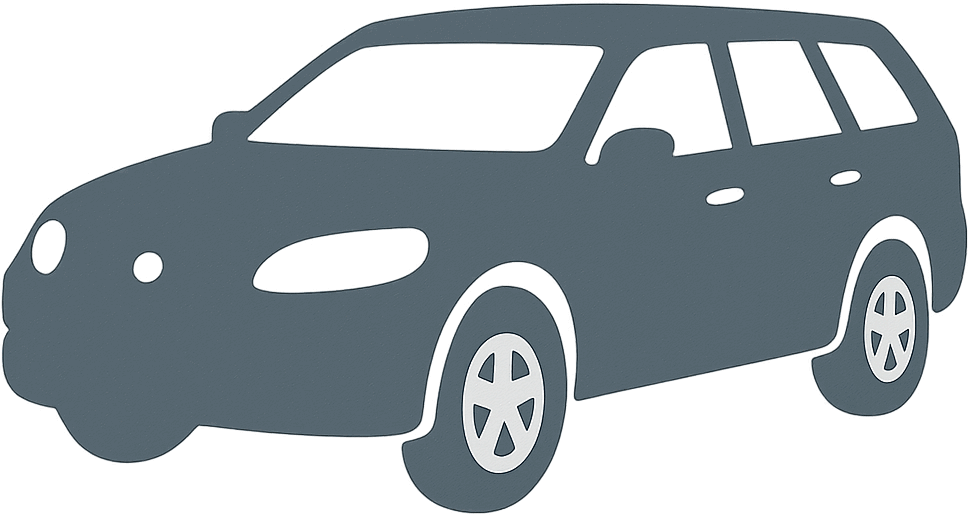 1955 DeSoto Firedome II Station Wagon Dimensions, Size & Specs
1955 DeSoto Firedome II Station Wagon Dimensions, Size & Specs
Measurements of the 1955 DeSoto Firedome II Station Wagon, engineered for optimal performance and comfort
| Dimensions | |
|---|---|
| Length: | 5552 mm218.6 in18.2 ft |
| Width: | 1989 mm78.3 in6.5 ft |
| Height: | 1539 mm60.6 in5.0 ft |
| Ground Clearance: | 160 mm6.3 in0.5 ft |
The 1955 DeSoto Firedome II Station Wagon represents a notable classic American vehicle from the mid-1950s, produced between 1954 and 1955. This model stands out for combining the robust style typical of DeSoto with practical station wagon utility. Measuring 5552 mm (218.5 inches) in length, the Firedome II offers a spacious body ideal for families and cargo, reflecting the design priorities of its era. Its width spans 1989 mm (78.3 inches), providing ample interior space and contributing to a stable road presence. With a height of 1539 mm (60.6 inches), this vehicle maintains a relatively low profile for a station wagon, balancing aerodynamics with interior headroom. This DeSoto model features a ground clearance of 160 mm (6.3 inches), suitable for varying road conditions while ensuring easy entry and exit for passengers. The Firedome II Station Wagon is a distinct silhouette from the 1950s, combining size and style with the versatility expected from a family-oriented vehicle at the time. Its dimensions make it comparable to other mid-century American station wagons yet unique in the DeSoto lineup for its combination of size and functional design. Whether viewed as a collector’s piece or assessed for vintage car size comparison, the 1955 Firedome II offers a window into the mid-century automotive trends of spaciousness and style.
Discover the standout features that make the 1955 DeSoto Firedome II Station Wagon a leader in its class
Have a question? Please check our knowledgebase first.
The 1955 DeSoto Firedome II Station Wagon measures 5552 mm (218.5 inches) in length, 1989 mm (78.3 inches) in width, and has a height of 1539 mm (60.6 inches). These substantial dimensions reflect its spacious design typical of mid-1950s American station wagons, providing ample interior and cargo space for family or utility use. Its considerable length and width contribute to a roomy cabin environment and enhanced road presence.
The 1955 DeSoto Firedome II Station Wagon has a ride height (ground clearance) of 160 mm (6.3 inches). This clearance is fairly standard for vehicles of its era, offering a balance between a low center of gravity for stability and enough height to negotiate urban road obstacles such as curbs and light off-road terrain. However, given its size and weight, it's more oriented towards smooth pavement driving than off-road capability.
A standard residential garage typically has an interior width of about 2.4 to 2.7 meters (8 to 9 feet) and a length of around 5.5 to 6 meters (18 to 20 feet). The 1955 Firedome II Station Wagon, at 1989 mm wide (78.3 inches) and 5552 mm long (218.5 inches), will fit in terms of width but might be a tight fit lengthwise depending on the garage's exact dimensions. Height, at 1539 mm (60.6 inches), poses no issue for standard garage door clearances. Owners might need to maneuver carefully due to the width and length but overall, it can be accommodated in most standard garages.
Compared to the first generation DeSoto Firedome Station Wagon produced prior to 1954, the 1955 Firedome II Station Wagon grew in overall dimensions, particularly in length and width, reflecting a design trend toward larger and more spacious cars post-World War II. The increased length of 5552 mm (218.5 inches) and width of 1989 mm (78.3 inches) allowed for greater interior comfort and cargo capacity, making it more family-friendly and versatile. This evolution in size enhanced road presence and utility but also increased curb weight and parking considerations.
In comparison with similar mid-1950s American station wagons, such as the 1955 Chevrolet Bel Air Nomad and the 1955 Ford Country Squire, the DeSoto Firedome II Station Wagon holds its own in terms of size. Its length of 5552 mm (218.5 inches) is competitive, slightly longer than some contemporaries, while its width of 1989 mm (78.3 inches) also ranks among the wider models, contributing to a roomy interior. The Firedome's height of 1539 mm (60.6 inches) is fairly standard, balancing cargo capacity with aerodynamic considerations. Overall, it offers generous space and comfort typical of premium large station wagons of its era.
While specific curb weight data for the 1955 DeSoto Firedome II Station Wagon is not explicitly provided, vehicles of this size and type from the mid-1950s typically weighed between 2000 to 2300 kg (4,400 to 5,070 lbs). This substantial weight impacts driving dynamics by contributing to a stable ride at cruising speeds but can reduce agility and acceleration compared to lighter cars. The weight also affects fuel consumption and braking distances, making the vehicle more suited to relaxed driving rather than sporty performance.
The 1955 DeSoto Firedome II Station Wagon, with its generous exterior dimensions, offers spacious interior accommodations typical of American station wagons from the 1950s. It comfortably seats six to eight passengers depending on configuration, with ample legroom and headroom. The extended length facilitates a large cargo area behind the rear seats, making it practical for families or utility use. The interior layout emphasizes comfort and versatility, with folding rear seats in some configurations to expand cargo space.
Given its large dimensions—5552 mm (218.5 inches) in length and 1989 mm (78.3 inches) in width—the 1955 DeSoto Firedome II Station Wagon requires careful attention when parking and maneuvering in tight urban spaces. Its relatively modest ground clearance of 160 mm (6.3 inches) means cautious navigation over speed bumps or curbs. Although its overall size might feel cumbersome in congested city streets or compact parking spots, the wagon's fairly long wheelbase promotes smooth highway cruising and stability.
The 1955 DeSoto Firedome II typically featured a V8 engine, the hallmark of the Firedome series, known for delivering robust power and smooth performance for its time. The engine choice provided reliable acceleration and cruising ability, well-suited to the vehicle's size and intended use as a family or utility wagon. The powertrain emphasized durability and ease of maintenance rather than outright speed, aligning with the practical nature of station wagons during this period.
The 1955 DeSoto Firedome II Station Wagon offers a versatile cargo area thanks to its long body and station wagon design layout. With rear seats folded down or removed, it provides substantial cargo volume suitable for transporting large items, luggage, or equipment. This flexibility made it popular among families, tradespeople, and travel enthusiasts in the 1950s. The station wagon format combined passenger comfort with utility, and the durable construction supported a range of loading needs while maintaining a smooth ride.
Discover similar sized cars.

| Production: | 1955-1956 |
|---|---|
| Model Year: | 1956 |
| Length: | 5552 mm218.6 in |
| Width: | 1989 mm78.3 in |
| Height: | 1539 mm60.6 in |
